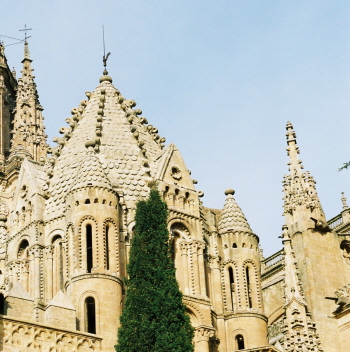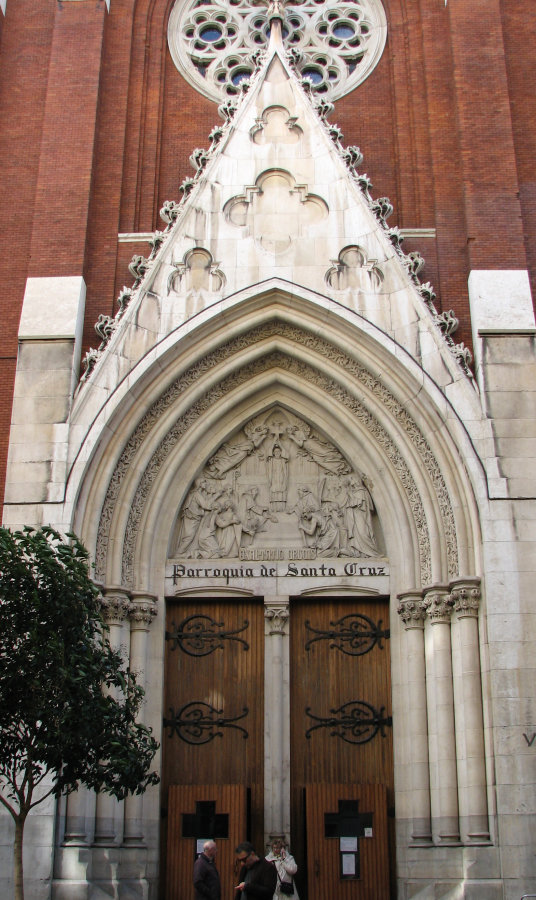Salamanca is far from unknown as a destination for travelers in Spain – but like Toledo, lack of time or knowledge can mean that most people hit only the high points and miss some very interesting sights. Yes, this city can be “done” in a day from Madrid if you hurry, but with a little more time you can see a lot more, and you can make your return visits with Aunt Gertie, cousin Joe, or college roomate Amy more interesting for you – and for them – if you have some tricks up your sleeve.
So this article is a quick guide to some of the lesser-known sights – and less about the major sights because they’re so easy to discover.
Must-see number one: Of course you should see the Cathedrals – note the plural as Salamanca has two Cathedrals side by side, a fantastic lesson in architecture that spans six centuries. Don’t miss the old Cathedral (to the right of the new), including the cloister where the University held exams before their buildings were completed. Jazz up this classic visit: Outside the new Cathedral you must look for the astronaut and the devil with something surprising in his hand – they’re around the north door and even for kids are much easier to find than the famous frog on the University façade. Incongruous on this 16-18th c building, they were added during a restoration in the 1990’s as a sort of signature and statement that work had been done in modern times.
Another unusual view of the Cathedrals is from the square behind the old Cathedral (photo to left). There you can see the fairy-tale turrets around the scaled dome of the old Cathedral, the rooster weathervane – and appreciate the difference in size between the two buildings and how they literally share a wall.
Cathedral add-on, in my opinion a must-see: The roof / towers. Entrance is on south side of the old Cathedral (opposite side from the new), takes you up and up the very top of the belltower. On the way you see the old bell-ringers quarters, birds-eye view inside both Cathedrals from the foot, entire length of the naves, and a wander on parts of the rooftop walkways. Information panels in all the right stopping places (and more!). Yes, lots of stairs and some a little uneven or narrow, but worth it unless physical issues would make it impossible or torturous. Not for anyone with fear of heights (obviously). Idea: try to be at top of the belltower on the hour for a big-ring (10-12?), or not, it could be really loud!
Continue your wanders down to the river to see the Roman bridge spanning the Tormes river. The fifteen arches closest to the city are 1st century Roman and the rest rebuilt in the 16th century. In Roman times Salamanca was a stop on the “Silver Way” from the Roman gold mines in the north all the way south to Sevilla, now this route is one of the alternative Roads of St. James – you can spot bronze shells in the city pavement if you look a bit. Walk across the bridge and look back for an interesting view of the city, including part of the old city walls (wall sleuths: it’s easy to imagine the line of the city walls looking at a map. Hint: Puerta Zamora was the north gate).
Also from the river, a bit to the east of the bridge, you can see the back view of the Casa Lis. This Art Nouveau-Art Deco museum is a real surprise in 15-16th century Salamanca and is a must-see for anyone interested in early 20th century art, both for the building itself and for the excellent collection of dolls, toys, bronze and ivory statues and glassware. Fabulous gift shop. The entrance to this museum is near the back side of the old cathedral. Doesn’t sound like your thing? Think again! Get a preview here http://www.museocasalis.org/nuevaweb/
The other must-do is University (one of the oldest in Europe) including the the façade, where tradition dictates that you find the lucky frog – a tough job on the ornately carved Plateresque (silversmith) style section over the door, but there is almost always someone there who can help.
Head back towards Salamanca’s famous Plaza Mayor on Rua Mayor with a quick stop at the Casa de las Conchas – the shell-studded outside is great but if open, you should also go inside to see the patio – note the “mixtilinear” arch typical of Salamanca’s palaces. If you want a less transited route back to the main square, continue north on Compañia street then take Meléndez to the right – this route has fewer tourists than Rua Mayor and a number of small restaurants and stores.
Salamanca’s 18th century Plaza Mayor (main square) was used as a bullring for around 100 years. Like Madrid’s main square, Salamanca’s square is a symentrical and completely enclosed. There are lots of outdoor cafés but beware! they’re much more expensive than cafés just a few blocks away.
Market: If you like food (who not?) or just want a glimpse of local life, check out the main market, right next to the Plaza Mayor on the east side. Be sure to walk around the outside of the market as well as going inside. Get more info (schedule, etc) at http://www.mercadocentralsalamanca.com/
If you still have time you might want to try to see San Marcos church at the north end of calle Zamora, 10-15 minutes walk from the Plaza Mayor on a pedestrian shopping street. This 12th century Romanesque church is a personal favorite: completely round, probably as a defense strategy as it was just inside the city walls. If you’re lucky enough to find it open (usually only for Mass), note how three naves are created in this small and ususually shaped space.
Tourist information for Salamanca: www.salamanca.es Look for the link about visiting times (horarios de monumentos) , especially for the more unusual sights (at present it’s towards bottom of home page under Oficina de Turismo on-line, but they redesign web every now and then). Once in the city, you can get a good basic map and ask questions at the tourism offices in the Plaza Mayor.
Getting to Salamanca: There’s very good public transportation to Salamanca – both train and bus. Take care when purchasing as there are fast and slow options for both train and bus, evident on schedules. Relevant websites: www.renfe.com for train and www.avanzabus.com for bus.


